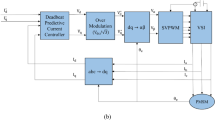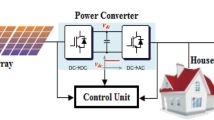Abstract
This paper deals wind energy based power generation system using Permanent Magnet Synchronous Generator (PMSG). It is controlled using advanced enhanced phase-lock loop for power quality features using distribution static compensator to eliminate the harmonics and to provide KVAR compensation as well as load balancing. It also manages rated potential at the point of common interface under linear and non-linear loads. In order to have better efficiency and reliable operation of PMSG driven by wind turbine, it is necessary to analyze the governing equation of wind based turbine and PMSG under fixed and variable wind speed. For handling power quality problems, power electronics based shunt connected custom power device is used in three wire system. The simulations in MATLAB/Simulink environment have been carried out in order to demonstrate this model and control approach used for the power quality enhancement. The performance results show the adequate performance of PMSG based power generation system and control algorithm.








Similar content being viewed by others
References
S. Mathew, Wind Energy: Fundamentals, Resource Analysis and Economics (Springer, Berlin, 2006)
P.O. Ohiero, C. Cossar, J. Melone, A fast simulation model for a permanent magnet synchronous generator (PMSG) drive system, in Proceedings of 16th European Conference on Power Electronics and Applications, Lappeenranta, 2014, pp. 1–10
V. Yaramasu, B. Wu, P.C. Sen, S. Kouro, M. Narimani, High-power wind energy conversion systems: state-of-the-art and emerging technologies. Proc. IEEE 103(5), 740–788 (2015)
M.E. Haque, M. Negnevitsky, K.M. Muttaqi, A novel control strategy for a variable-speed wind turbine with a permanent-magnet synchronous generator. IEEE Trans. Ind. Appl. 46(1), 331–339 (2010)
J.C. Wu, Y.H. Wang, Power conversion interface for small-capacity wind power generation system. IET Gener. Transm. Distrib. 8(4), 689–696 (2014)
R. Krishnan, Permanent Magnet Synchronous and Brushless DC Motor Drives (CRC Press, Boca Raton, 2010)
J.J. Han, J.C. Wu, H.-L. Jou, A simplified control algorithm for wind-power battery charger, in Proceedings of 9th IEEE Conference on Industrial Electronics and Applications, Hangzhou, 2014, pp. 385–390
K.R. Sekhar, R. Barot, P. Patel, N.V. Kumar, A novel topology for improved DC bus utilization in PMSG based wind energy generation system, in Proceedings of International Conference on Renewable Energy Research and Applications (ICRERA), Palermo, 2015, pp. 525–530
A.A. Ahmed, K.M. Abdel-Latif, M.M. Eissa, S.M. Wasfy, O.P. Malik, Study of characteristics of wind turbine PMSG with reduced switches count converters, in Proceedings of 26th Annual IEEE Canadian Conference on Electrical and Computer Engineering (CCECE), 2013, Regina, pp. 1–5
A. Ghosh, G. Ledwich, Power quality enhancement using custom power devices (Springer, Delhi, 2009)
M. Barghi Latran, A. Teke, Y. Yoldas, Mitigation of power quality problems using distribution static synchronous compensator: a comprehensive review. IET Power Electron. 8(7), 1312–1328 (2015)
J. Jayachandran, R. Murali Sachithanandam, Neural network-based control algorithm for DSTATCOM under nonideal source voltage and varying load conditions. Can. J. Electr. Comput. Eng. 38(4), 307–317 (2015)
A.K. Sahoo, T. Thyagarajan, Modeling of facts and custom power devices in distribution network to improve power quality, in Proceedings of International Conference on Power Systems, 2009, Kharagpur, 2009, pp. 1–7
L. Greenstein, Phase-locked loop pull-in frequency. IEEE Trans. Commun. 22(8), 1005–1013 (1974)
A. Mann, A. Karalkar, L. He, M. Jones, The design of a low-power low-noise phase lock loop, in Proceedings of 11th International Symposium on Quality Electronic Design (ISQED), 2010, San Jose, CA, 2010, pp. 528–531
A.M. Salamah, S.J. Finney, B.W. Williams, Three-phase phase-lock loop for distorted utilities. IET Electr. Power Appl. 1(6), 937–945 (2007)
S.R. Al-Araji, K.A. Mezher, Q. Nasir, First-order digital phase lock loop with continuous locking, in Proceedings of Fifth International Conference on Computational Intelligence, Communication Systems and Networks, Madrid, 2013, pp. 414–417
A.B. Shitole, H.M. Suryawanshi, S. Sathyan, Comparative evaluation of synchronization techniques for grid interconnection of renewable energy sources, in Proceedings of 41st Annual Conference of the IEEE Industrial Electronics Society, Yokohama, 2015, pp. 1436–1441
M. Karimi Ghartemani, Enhanced Phase-Locked Loop Structures for Power and Energy Applications (Wiley, Hoboken, 2014)
B. Singh, S. R. Arya, Software PLL based control algorithm for power quality improvement in distribution system, in Proceedings of IEEE 5th India International Conference on Power Electronics (IICPE), Delhi, 2012, pp. 1–6
B. Singh, S.R. Arya, Implementation of single-phase enhanced phase-locked loop-based control algorithm for three-phase DSTATCOM. IEEE Trans. Power Deliv. 28(3), 1516–1524 (2013)
Author information
Authors and Affiliations
Corresponding author
Appendix
Appendix
KW Wind Turbine Parameters
Rotor diameter: 10 m, rotor rated speed: 300 r.p.m, cut-in wind speed: 3 m/s, rated wind speed: 15 m/s, inertia: 18 kg m2.
The \( f_{p} (\lambda ) \) curve of the wind turbine can be expressed approximately using the following polynomial equation [1]:
where, f1 = 0.5176, f2 = 116, f3 = 0.4, f4 = 5, f5 = 21, f6 = 0.0068, tip speed ratio (λ) = 0.54, pitch angle (β), internal coefficient (λi) and optimum value of power coefficient (f pmax ) = 0.495.
KW PMSG Parameters
Rated phase voltage: 240 V, line current (rated): 16.86 A, rated frequency: 50 Hz, rated speed: 300 r.p.m, L 1 d = L 1 q = 15 mH, magnetic flux: 0.80 Wb, Rs = 1.8 O, pole pairs: 10, inertia: 0.140 kg m2.
DSTATCOM Parameters
Supply: 3-phase, 415 V (L–L), 50 Hz; load: (1) linear: series connected resistive and inductive load operated at 7.5 kVA with p.f. 0.8 (lagging); (2) non-linear: Three phase thyristorised rectifier load with firing angle (α = 20°) connected to RL load with value R = 29 Ω, L = 70 mH; battery voltage (V B ): 700 V; interfacing inductor \( (L_{f} ) \) = 3 mH, sampling time \( (t_{s} ) \) = 100 μs, cut off frequency of low pass filter used in frequency loop = 2nd order, 14 Hz, ripple filter: \( R_{f} \) = 4.5\( \varOmega \), \( C_{f} \) = 10 μF, cut off frequency of low filter used in amplitude of terminal voltage: 2nd order, 11 Hz, gains of PI controller for frequency controlled loop: \( k_{pd} = 1.968 \), \( k_{id} = 2.85 \); gains of ac voltage PI controller: \( k_{pq} = 4.5 \), \( k_{iq} = 0.5 \).
The Relation between Wind Speed, Power and Mechanical Torque
The wind power acting on the swept area, A, of the blade is a function of the air density \( \rho \) and the wind speed \( V_{w} \). The transmitted power \( P_{m} \) is generally deduced from the wind power using the power coefficient \( F_{p} \), as:
The power coefficient is a non-linear function of the tip speed ratio λ which depends on the wind velocity and the rotation speed of the shaft ω.
where, R represents the blade radius. As the wind turbine and generator shafts are directly coupled, there is only one state variable. So, that relation between wind speed, electromagnetic torque, and mechanical torques are related as:
where, Tm is the mechanical torque, Te is the electromagnetic torque, ω is the mechanical speed of the rotor, j is the moment of inertia and f is the coefficient of viscous friction.
Rights and permissions
About this article
Cite this article
Arya, S.R., Patel, A. & Giri, A. Isolated Power Generation System Using Permanent Magnet Synchronous Generator with Improved Power Quality. J. Inst. Eng. India Ser. B 99, 281–292 (2018). https://doi.org/10.1007/s40031-018-0316-x
Received:
Accepted:
Published:
Issue Date:
DOI: https://doi.org/10.1007/s40031-018-0316-x




